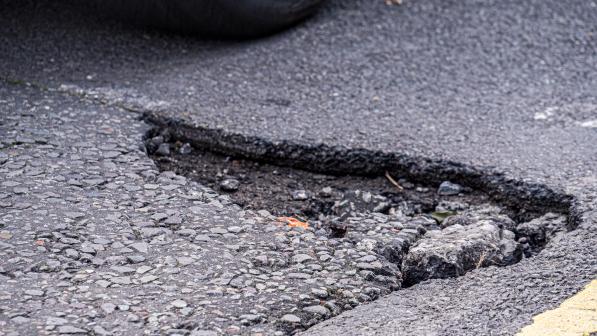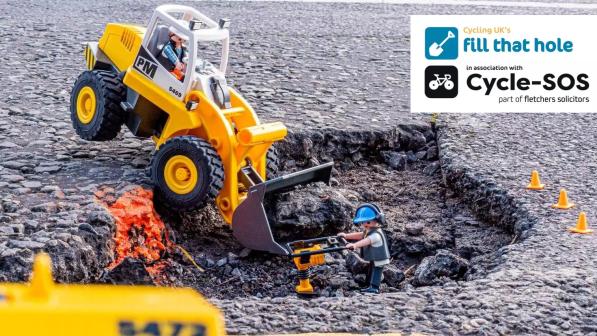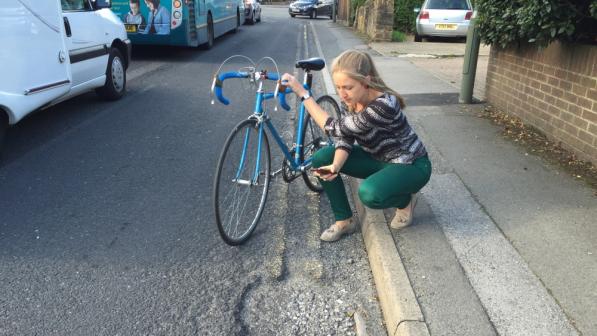How to handle potholes on a bike

January and February are peak pothole time on UK roads – when the weather is at its coldest and wettest. The RAC estimates that there are at least one million potholes on our roads. For motorists these holes in the road are rarely little more than an inconvenience, although they can damage cars if they’re severe enough.
For cyclists, however, they can be much more dangerous. They can cause all kinds of damage to bikes, from punctures to buckled wheels or even a broken frame. More seriously, they can lead to severe injuries, including bruising, broken limbs or head injuries. Cyclists have even died from injuries or being thrown into the path of motor vehicles.
A survey of UK cyclists for National Pothole Day 2022 found that 21% have been involved in an accident because of a pothole, with 22% of those incidents resulting in a personal injury, while 63% suffered damage to their bike because of one.

How potholes form
Potholes are collapsed areas in the tarmac resulting from a combination of bad weather and the pressure of traffic. The main issue is the ‘freeze and thaw cycle’ that’s so typical of a British winter.
Roads develop cracks through normal wear and tear. Water seeps into these cracks. This turns to ice during freezing conditions which expands, further damaging the road. When the ice melts it leaves a gap. As this repeated throughout winter potholes form.
This is exacerbated by the weight of cars driving over the cracks and holes, further weakening the road surface. As cars get bigger and heavier and more people buy SUVs, this will only get worse.
If it seems like UK roads are particularly potted with potholes, you could be right. Our increasingly wet winters combined with cold snaps followed by warmer spells create the ideal conditions for potholes to form.
A lack of investment in road maintenance doesn’t help either. Quieter, back roads – the type often sought out by cyclists – are more likely to be affected by this.
The RAC estimates that there are there are around six potholes per mile on council-controlled roads in England and Wales. The organisation said that the UK’s pothole problem contributed to more than 22,000 RAC breakdowns in 2024.

Avoidance is best
Before heading out make sure your tyres are in good condition. This will reduce risk of damage.
You can let a bit of air out of the tube to improve comfort and grip, but don’t go too far below the recommended pressure as this will risk pinch punctures – when hitting a sharp edge (like the rim of a pothole) pinches the innertube hard enough against the rim to tear the tube. If you’re running tubeless tyres, though, this won’t be an issue.
You can also swap your tyres for hardier winter versions. If there’s clearance, fatter ones will give you better grip. Some people even go so far as having a dedicated winter bike.
It’s best to avoid potholes where you can. If you usually stick to quieter roads, you can change your route to more main roads as these are more likely to be well maintained and well lit.
If you ride at night, make sure you have bright enough lights to spot any potential hazards – the law states that you should have front and rear lights if riding between sunset and sunrise.
Potholes can form overnight, so don’t get complacent. Ride more slowly, setting off early to give yourself more time if need be. Scan the road ahead, keeping an eye out for discoloured patches. Watching other cyclists helps too – an unexpected swerve from the rider ahead could indicate a dangerous road defect.
Anticipating any hazards will give you more time to react. Swerving into the road can be dangerous, so good road positioning will help. Staying away from the kerb will give you space to manoeuvre safely, allowing you to go left or right as necessary.
Never ride through puddles, however much fun it might be. Standing water can easily hide a deep and dangerous pothole.

Ride through it
Sometimes, though, it’s not possible to avoid the pothole. In which case it’s good to know how to ride it safely.
If there’s time and the pothole isn’t too big, you might be able to ‘jink’ around it. This involves turning the handlebar quickly in one direction and then back again. Your front wheel should steer around the pothole while you – and often your back wheel – continue over it.
However, if you have doubts about doing this, it’s best not to attempt it. You risk your front wheel going one way and you and your back wheel going the other.
If you have no choice but to ride over a pothole, stand up out of your seat slightly and keep your pedals level. Lean your body back and drop your heels so you can brace your feet against the pedals. You’re much less likely to go over the handlebar if your weight is behind the bike rather than over it.
Hold the handlebar firmly, but keep your muscles relaxed and elbows and knees slightly bent. Hit the pothole square on and ride straight over it. Don’t attempt to steer and don’t brake – now isn’t the time to take your hands off the bars.

If you hit the hole
If these manoeuvres don’t work and you end up taking a tumble, there are a few procedures you should follow. First, assess both you and your bike for damage. If you’ve suffered an injury, make sure you get medical attention if needed.
If you or your bike have been damaged, you should seek legal advice. Take note of the date and time. If there are any witnesses take their details so that if you do decide to pursue a personal injury claim your solicitor can get a full statement.
If you can, take photos of the pothole and record its depth and width, plus its position in the road and location of the road itself. Also document any injuries to yourself or damage to your bike or clothing. If you receive medical attention, keep a record of your medical notes and any medication prescribed.
Cycling UK members get free advice from our legal partners Cycle SOS. Full insurance will give you peace of mind; members also receive discounts on cycle insurance from Bikmo.
Fill That Hole
Local authorities are responsible for maintaining roads within their jurisdiction, including fixing potholes. They are required to carry out regular inspections. But they can’t fix potholes if they don’t know about them, and potholes form so quickly it’s impossible for authorities to take note of them all.
Authorities rely on road users to report potholes, and this is where you can help. Cycling UK’s Fill That Hole web app allows you to quickly and easily report any potholes you come across.
All you need to do is fill in a form with all the details requested and it will automatically be sent to the relevant authority. The form also allows you to report a variety of other road hazards and issues. The website is mobile friendly so you don’t need to download an app – just bookmark the webpage and you’re ready to go.
Reporting any potholes you find while out on your bike will help make the roads that bit safer for all of us.



